Related Research Articles

Blitzkrieg or Bewegungskrieg is a word used to describe a combined arms surprise attack using a rapid, overwhelming force concentration that may consist of armored and motorized or mechanized infantry formations; together with artillery, air assault, and close air support; with intent to break through the opponent's lines of defense, dislocate the defenders, unbalance the enemies by making it difficult to respond to the continuously changing front, and defeat them in a decisive Vernichtungsschlacht: a battle of annihilation.
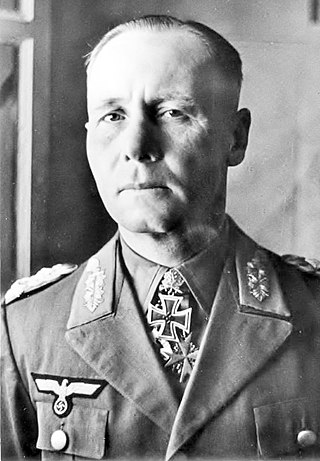
Johannes Erwin Eugen Rommel was a German Generalfeldmarschall during World War II. Popularly known as the Desert Fox, he served in the Wehrmacht of Nazi Germany, as well as serving in the Reichswehr of the Weimar Republic, and the army of Imperial Germany. Rommel was injured multiple times in both world wars.
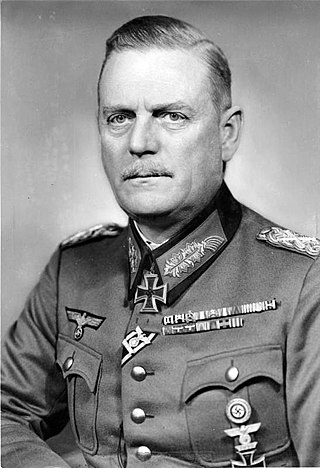
Wilhelm Bodewin Johann Gustav Keitel was a German field marshal who held office as chief of the Oberkommando der Wehrmacht (OKW), the high command of Nazi Germany's armed forces, during World War II.
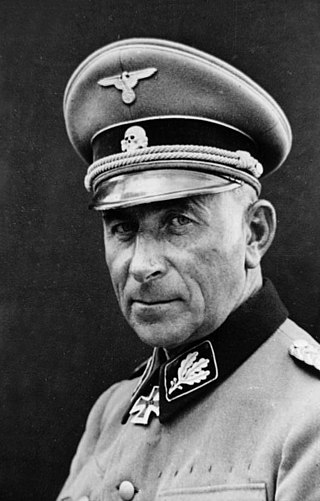
Paul Hausser also known as Paul Falk after taking his maiden name post war was a German general and then a high-ranking commander in the Waffen-SS who played a key role in the post-war efforts by former members of the Waffen-SS to achieve historical and legal rehabilitation.

Gotthard Fedor August Heinrici was a German general during World War II. Heinrici is considered to have been the premier defensive expert of the Wehrmacht. His final command was Army Group Vistula, formed from the remnants of Army Group A and Army Group Center to defend Berlin from the Soviet armies advancing from the Vistula River.

Georg Thomas was a German general in the Third Reich. He was a leading participant in planning and carrying out economic exploitation of the Soviet Union, most notably the Hunger Plan. Thomas's role in plotting against Hitler has led some historians to describe him as a member of the German resistance, while others find his record more ambiguous.

During World War II, the German Wehrmacht committed systematic war crimes, including massacres, mass rape, looting, the exploitation of forced labour, the murder of three million Soviet prisoners of war, and participated in the extermination of Jews. While the Nazi Party's own SS forces was the organization most responsible for the genocidal killing of the Holocaust, the regular armed forces of the Wehrmacht committed many war crimes of their own, particularly on the Eastern Front.

Friedrich Karl Albert Dollmann was a German general during World War II who commanded the 7th Army during the Invasion of France and the early phases of the Allied invasion of Normandy until his death in June 1944.

Georg Stumme was a general in the Wehrmacht of Nazi Germany during the Second World War who briefly commanded the Axis forces at the beginning of the Second Battle of El Alamein, and died during the Defence of Outpost Snipe. He had taken part in the Battle of France, the invasion of Yugoslavia and Operation Barbarossa, the invasion of the Soviet Union. He was a recipient of the Knight's Cross of the Iron Cross, the highest award in the military and paramilitary forces of Nazi Germany during the war.

The German Army was the land forces component of the Wehrmacht, the regular armed forces of Nazi Germany, from 1935 until it effectively ceased to exist in 1945 and then was formally dissolved in August 1946. During World War II, a total of about 13.6 million soldiers served in the German Army. Army personnel were made up of volunteers and conscripts.
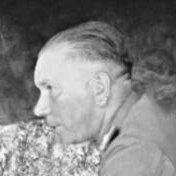
Walther Nehring was a German general in the Wehrmacht during World War II who commanded the Afrika Korps.
Gustav Anton von Wietersheim was a German general during World War II. He led the XIV Motorized Corps from its creation in 1938 until 14 September 1942 during the Battle of Stalingrad.

Otto Deßloch was a German Luftwaffe general during World War II and recipient of the Knight's Cross of the Iron Cross with Oak Leaves of Nazi Germany.
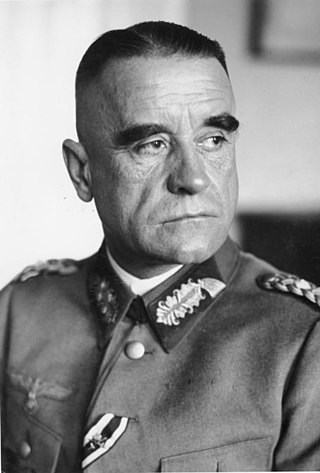
Walter Heitz was a German general (Generaloberst) in the Wehrmacht during World War II who served as President of the Reich Military Court and commanded part of the 6th Army in the Battle of Stalingrad.
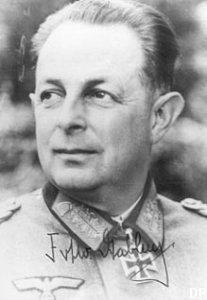
Eccard Freiherr von Gablenz was a German general in the Wehrmacht during World War II who commanded several divisions. He participated in the campaigns of Poland, France and the invasion of the Soviet Union. Gablenz stayed on the Russian Front from 1941 to 1943. He later assumed command of the 232nd Infantry Division in Italy, a command he held until the final surrender in May 1945.

The Myth of the Eastern Front: The Nazi–Soviet War in American Popular Culture (2008) by Ronald Smelser and Edward J. Davies, is a historical analysis of the post-war myth of the "Clean Wehrmacht", the negative impact of the Wehrmacht and the Waffen-SS mythologies in popular culture, and the effects of historical negationism upon cultural perceptions of the Eastern Front of the Second World War.
The Rommel myth, or the Rommel legend, is a phrase used by a number of historians for the common depictions of German Generalfeldmarschall Erwin Rommel as an apolitical, brilliant commander and a victim of Nazi Germany due to his presumed participation in the 20 July plot against Adolf Hitler, which led to Rommel's forced suicide in 1944. According to these historians, who take a critical view of Rommel, such depictions are not accurate.
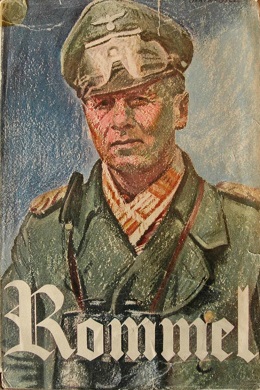
Rommel: The Desert Fox is a 1950 biography of German Field Marshal Erwin Rommel by Desmond Young. The book was the first biography of Rommel and enjoyed immense popularity, especially in Britain. The book led the Western Allies, particularly the British, to depict Rommel as the "good German" and "our friend Rommel", contributing to the formation of the Rommel myth.

Alfred-Ingemar Berndt was a German Nazi journalist, writer and close collaborator of Reich Minister of Public Enlightenment and Propaganda Joseph Goebbels.
References
- 1 2 Samuel W. Mitcham – Audio Books, Best Sellers, Author Bio | Audible.com.
- 1 2 3 "Book Samuel W. Mitcham, Jr. | Speakers Bureau | Booking Agent Info". All American Speakers. Retrieved 2022-09-04.
- ↑ "Samuel W. Mitcham, Jr". Simon & Schuster . Retrieved 2022-09-03.
- ↑ Mitcham, Samuel W. (November 22, 2012). Richard Taylor and the Red River Campaign of 1864. Pelican Publishing Company. ISBN 9781455616343 – via Google Books.
- ↑ Samuel W. Mitcham, Publishers Weekly
- ↑ "Samuel W. Mitcham Jr". Regnery Publishing . Retrieved 2022-09-04.
- ↑ Mitcham, Samuel W. (2020). "Why the Civil War Wasn't About Slavery – Abbeville Institute". Abbeville Institute . Retrieved 27 July 2021.
- ↑ Whaley, Joachim (1997). "Reviews : Why Hitler? The Genesis of the Nazi Reich. By Samuel W. Mitcham, Jr. Westport, Connecticut and London: Praeger, 1996. Pp. xii + 207. £17.50". Journal of European Studies. 27 (4): 472–473. doi:10.1177/004724419702700416. ISSN 0047-2441. S2CID 162375352.
- 1 2 "Book Review: The Desert Fox in Normandy: Rommel's Defense of Fortress Europe (Samuel W. Mitcham, Jr.) : WW2". HistoryNet . 2001-08-12. Retrieved 2022-09-04.
- ↑ Minniear, Steven S. (1 April 1998). "The Desert Fox in Normandy: Rommel's Defense of Fortress Europe by Samuel W. Mitcham (review)". The Journal of Military History. 62 (2): 442. doi:10.2307/120769. JSTOR 120769.
- 1 2 3 Fullenkamp, Lee (2001). "Retreat to the Reich: The German Defeat in France, 1944 by Samuel W. Mitcham (review)". Parameters . 31 (4): 154–156. ProQuest 198060795.
- ↑ "Retreat to the Reich: The German Defeat in France, 1944 by Samuel W. Mitcham, Jr". Publishers Weekly . Retrieved 2022-09-04.
- 1 2 Bradley Nichols (February 2011): Nichols on Mitcham, 'Defenders of Fortress Europe: The Untold Story of the German Officers during the Allied Invasion', H-Net
- 1 2 3 Staruk, Henry (2006). "Staruk on Mitcham, 'Panzers in Winter: Hitler's Army and the Battle of the Bulge' | H-German | H-Net". networks.h-net.org. Retrieved 2022-09-04.
- 1 2 "Eagles of the Third Reich by Samuel W. Mitcham, Jr". Publishers Weekly . Retrieved 2022-09-04.
- ↑ Reinhold, Herman (22 December 2012). "Eagles of the Third Reich: Men of the Luftwaffe in World War II". Air Power History. 59 (4): 49–50.
- ↑ "Crumbling Empire: The German Defeat in the East, 1944 by Samuel W. Mitcham, Jr". Publishers Weekly . Retrieved 2022-09-04.
- 1 2 "Hitler's Commanders: Officers of the Wehrmacht, the Luftwaffe, the Kriegsmarine and the Waffen-SS, 2nd edition by Samuel W. Mitcham, Jr., Gene Mueller". Publishers Weekly . Retrieved 2022-09-04.
- 1 2 3 Baker, Lee. "Reviews: The German Defeat in the East, 1944-1945, by Samuel W. Mitcham". Journal of Slavic Military Studies . Jul-Sep 2008, Vol. 21, Issue 3, pp. 593-594. doi : 10.1080/13518040802313985. (AN: 33998522)
- 1 2 3 Eubank, Keith "Mitcham, Samuel W., Jr.: The rise of the Wehrmacht: the German armed forces and World War II". CHOICE: Current Reviews for Academic Libraries, vol. 46, no. 10, June 2009, p. 2015
- ↑ James S. Corum (2008). "The Rise of the Wehrmacht: The German Armed Forces and World War II (review)". The Journal of Military History. 73 (1): 306–307. doi:10.1353/jmh.0.0209. ISSN 1543-7795. S2CID 159505567.
- ↑ Sinisi, Kyle (2013-01-01). "Richard Taylor and the Red River Campaign of 1864". Civil War Book Review. 15 (3). doi: 10.31390/cwbr.15.3.25 . ISSN 1528-6592.
- ↑ Smith, Michael Thomas (2013-11-01). "Richard Taylor and the Red River Campaign of 1864". Journal of Southern History. 79 (4): 976–978.
- ↑ Mitcham, Samuel W. (14 January 2020). It Wasn't About Slavery. Simon and Schuster. pp. xvii. ISBN 9781621578772 . Retrieved 27 July 2021.
- ↑ Kizer Jr., Gene (3 February 2022). "It Wasn't About Slavery, Exposing the Great Lie of the Civil War by Samuel W. Mitcham, Jr. – A Comprehensive Review by Gene Kizer, Jr., Part Fifteen, Conclusion". Charleston Athenaeum Press. Retrieved 2022-09-04.
- ↑ Kizer Jr., Gene (28 October 2021). "It Wasn't About Slavery, Exposing the Great Lie of the Civil War by Samuel W. Mitcham, Jr. - A Comprehensive Review by Gene Kizer, Jr., Part One". Charleston Athenaeum Press. Retrieved 2022-09-04.
- ↑ Mitcham, Samuel W. (4 October 2016). Bust Hell Wide Open: The Life of Nathan Bedford Forrest. Simon & Schuster. ISBN 9781621576006 . Retrieved 27 July 2021.
- ↑ Roesch, James Rutledge (11 July 2017). "Bust Hell Wide Open". Abbeville Institute, an organization which is neo-Confederate and an apologist for slavery in the American South. Retrieved 2022-09-04.